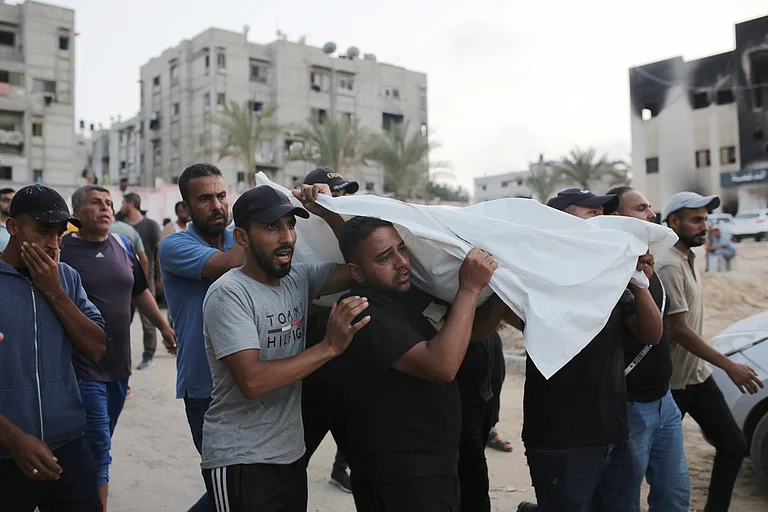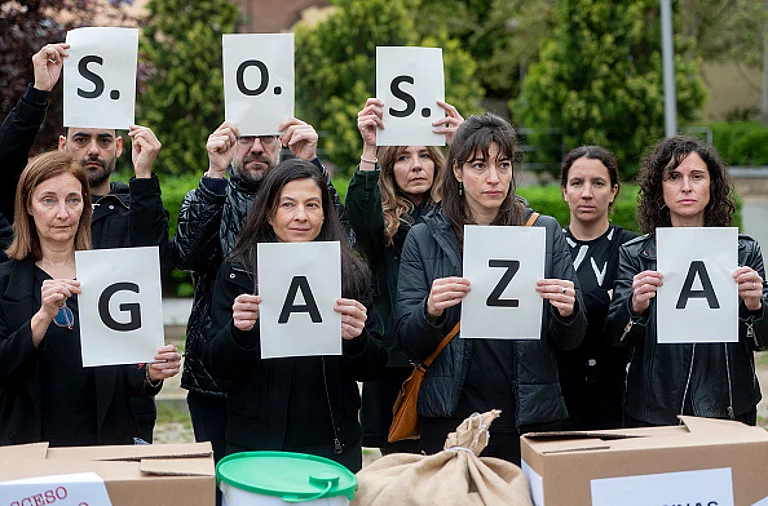A lot has been said about the bias in editorial positions of several leading Western sources of news when it comes to their reports on Israel’s war in Gaza and the Israel-United States-Iran conflict. But that hasn’t stopped the mainstreaming of words like “terrorists” (versus “freedom fighters”) or “rebels” (versus “militants”), that colour how readers perceive a group, region or even an individual’s actions.
War Of Words: Whose Story Gets Told In Israel-Gaza-Iran Disputes?
A prominent section of the Western media faces criticism for using highly emotive words and outright bias in reporting on Israel's conflicts with Gaza and Iran.
These choices reflect conscious or unconscious leanings, and the warning sign is usually the repeated use of emotionally charged language. Such language can overwhelm a reader or viewer’s judgement about a situation or event and force them into taking sides. It can influence wider public opinion on a conflict, potentially dehumanising one side or presenting another side as an aggressor.
Not long ago, The Intercept analysed content featured in The New York Times, the Washington Post and the Los Angeles Times over the first six weeks of the Israel-Gaza conflict—October 7 to November 24, 2023. It studied over 1,000 reports (minus editorials and letters to the editor) and tallied the language used and its context. It found a “routine devaluing of Palestinian lives” that made it “more difficult” to humanise them. It found that for every two Palestinian deaths, Palestinians were mentioned once, while for every Israeli death, Israelis were mentioned eight times. As time progressed, the Palestinian death toll mounted—but references to Palestinians actually declined over those weeks in 2023.
Highly emotive words, such as “slaughter”, “massacre” and “horrific” were used to describe civilian killings in Israel sixty times more often than deaths in Gaza, where over 22,000 had been killed by Israeli fire in the first six weeks of the conflict. The Intercept also wrote, “Despite many high-profile instances of both antisemitism and anti-Muslim racism during the survey period, 87 per cent of mentions of discrimination [in the United States] were about antisemitism, versus 13 per cent mentions about Islamophobia, inclusive of related terms.”
The BBC has also been in the thick of a controversy of late, facing bias accusations from its own employees at a recent gathering of its staff. Employees sought explanations at a recent ‘town hall’ meeting for why the documentary, ‘Gaza: Doctors Under Attack’ was shelved, while another was taken off air from the iPlayer. While some, like the Asserson Report, have previously accused the BBC of an anti-Israel bias, this allegation was laid to rest by many other academic and non-academic studies, as pointed out by Media Reform Coalition, a United Kingdom-based platform dedicated to research and campaign around public-interest media coverage.
Contrasting the BBC’s coverage of the Russia-Ukraine conflict vis a vis the Israel-Gaza conflict, Media Reform noted: “Indeed, news organisations like the BBC have been extremely reluctant to describe Israel’s assault as a ‘genocide’ (unlike their willingness to do so in relation to Russia’s invasion of Ukraine). The situation changed only when the South African government brought evidence to the ICJ [International Court of Justice] in January 2024 which then found that there was a ‘plausible’ case that genocide was taking place. However, that was a brief interlude after which BBC stories about a genocide taking place in Gaza were few and far between.”
Unconscious and conscious biases
Terms like “radical” or “extremist” are often used when referring to groups or individuals from West Asia rather than similar groups in other parts of the world, who may be described as “activists” or “rebels” instead. This associates certain regions with violence or extremism.
Words like “unprovoked” or “indiscriminate”, especially when overused in the context of describing one party’s actions while framing the other party as more “strategic” or “measured”, reveals a subtle bias in framing the conflict.
Media outlets with specific political leanings might use words to reflect their editorial stance. Outlets sympathetic to the Israeli government may describe the Gaza conflict in terms like “Israel’s right to defend itself” while outlets critical of Israel may describe the same events as “Israel’s occupation and aggressive policies”.
A third exposé was published by The WaqWaq Tree/Muhammad Junaid, which revealed that Palestinians were referred to as ‘Palestinians’ far less often than they were reduced to ‘Gaza’ or ‘Hamas’ in 61,193 headlines published in The New York Times between October 2023 and June 2025—the present time. In contrast, Israelis were identified as Israelis, and rarely reduced to places/groups. Here’s what it says: “When Palestine becomes ‘Hamas-controlled territory’ and Iranians become ‘regime assets’, actual human beings disappear from public consciousness. Bombing becomes acceptable. Suffering becomes invisible. Consent is manufactured through the systematic theft of language itself.”
The WaqWaq Tree highlights five parameters around which ordinary readers can analyse bias in the content they are reading:
Identity Theft: People become places, governments become “regimes”
Agency Reversal: Victims become threats, resistance becomes terrorism
Sentiment Spikes: Negative framing increases during critical moments
Volume Manipulation: Fewer headlines during humanitarian crises
Vocabulary Bias: Institutional language for allies, militant language for targets
These are other instances of bias pointed out by numerous studies:
Gaza conflict coverage
“Israel strikes Gaza in self-defence” vs. “Israel bombs Gaza in retaliation”
The phrase “self-defence” implies a justified, defensive action, while “retaliation” suggests a response to an attack. Depending on which term is used, it can shift how the public views the actions being taken.
“Hamas militants” vs. “Palestinian militants”
The term “Hamas militants” specifically references the governing political group in Gaza, whereas “Palestinian militants” generalises the group to include all Palestinians. This impacts whether readers associate actions with an organisation or the entire Palestinian population.
“Israeli airstrikes kill civilians” vs. “Palestinian casualties rise”
The first phrasing emphasises the actions of Israel: killing civilians. The second focuses on the victims (“Palestinian casualties”), which can be seen as depersonalising the suffering in Gaza and obscuring the source of violence.
Iran conflict coverage
“Iran’s nuclear ambitions” vs. “Iran’s nuclear programme”
To say “nuclear ambition” is to convey doubt, implying that Iran has a desire to develop nuclear weapons. On the other hand, the phrase “nuclear programme” is far more neutral and focuses solely on Iran’s pursuit of nuclear energy or technology—a fact, without painting the country as being on the offensive.
“Regime crackdown” vs. “Iranian government response”
Describing actions as a “crackdown” carries negative connotations of authoritarianism. The word “response” would be seen as more neutral, though it might be seen as potentially minimising the severity of government actions against protesters or opposition groups.
“Terrorist state” vs. “State sponsor of terrorism”
“Terrorist state” is a label, not an ordinary term. It is emotionally charged language that is avoidable for media anywhere. However, “state sponsor of terrorism”, which implies a legal and political status has a more neutral tone. The former can vilify a country, while the latter suggests the state is involved but within a more institutional context.



